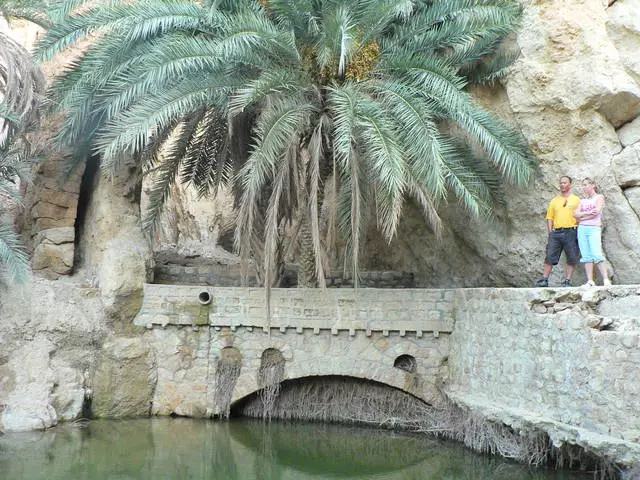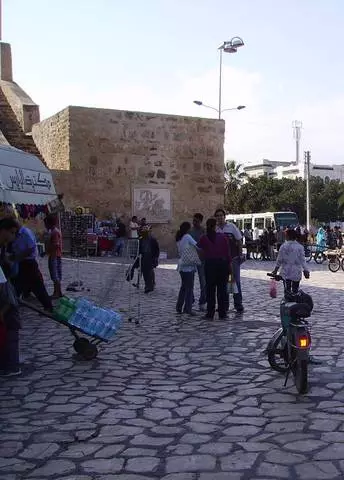The main resort of Tunisia - Sousse attracts tourists not only by snow-white beaches, the magical Mediterranean Sea and the nightlife rich for Arab countries. Interesting Sousse and attractions - colorful and traditionally-oriental. Almost all of them are concentrated in one place - Medina, or the historical center of the Sousse, from where it is worth a familiarity with architectural, cultural and religious monuments of the city.

Medina Suss
Medina, or the old town is the historic center of the Sousse. The streets here are narrow and winding, old houses, and the indescribable atmosphere of the Arab East hovers over all this. It is here that the main attractions of the resort are located: the Great Mosque, Kasba Fortress, Ribat, Archaeological Museum, as well as a lot of benches with souvenirs, jewelry and leather artisans.

Fortress Monastery Ribat
Ribat is the oldest Muslim fortress in North Africa, is located in the northeastern part of the medina. The fortress is crowned with a thirty-natimetime supervisory tower, with a great view of Medina, Sousse and surroundings. Served Ribat two goals: during hostilities defended the city from the sea, in the peace and time was used as a religious structure, where the soldiers prayed and studied the Quran. In the walls of Ribat are Celi, a chamoral room and a big courtyard. Be sure to rise to the second floor, where the footprint is preserved between the columns in the stone slab. They say that if you make a desire, coming to this imprint, it will certainly come true. The cost of the ticket to ribat for adults is 4 dollars, for children for free. The cost of photography is about a dollar. The fortress is open to visitors every day, except Monday.
Big Side Okba Mosque
A large or great mosque is next to the Ribat Fortress. The Sid-Okba Mosque is the ancient religious building of North Africa and one of the most important mosques of Tunisia. The mosque, at one time regularly rebuilt, looks very modest and more resembles the fortress, decorated with only two dome-shaped low-level minaret tower. There is a suggestion that the mosque also performed a protective and defensive destination with a ribath. From the height of the towers, an excellent panorama of the city opens, the courtyard of the mosque is decorated with antique columns, the prayer room is interesting for its pulpit, the oldest in the world, decorated with ceramic tiles and marble panels. However, it is necessary to remember that it is impossible to enter nonymusulmans during prayer in the milean hall. Also, despite the heat, it is worth remembering about its appearance: unacceptable open shoulders and feet in women, as well as uncovered head.
Fortress Kasba
Fort Fort Kasba, built on the ruins of the Byzantine Fortress, is one of the most ancient fortifications in the territory of Maghreb. The fortress is located in the southwestern part of the medina, on top of the hill. The Tower of the Fortress called Calef Al-Fata at one time served both Lighthouse and an observant post in wartime. Currently, part of the Kasba Fortress occupies the Archaeological Museum of the city, known for its exposition.
Archaeological Sousse Museum
The Archaeological Museum of Sousse is located in the southern part of the fortification of Kasba. The museum is the most valuable collection of Roman Mosaics, the second most important, after the Mosaic collection at the Bardo Museum. On mosaics depicted scenes from the life of a simple people and mythological beings: fishing, gladiatorial battles, centaurs, satires. Also in the museum are presented sculptures, tombstones, ceramics. The museum is open every day, except Monday, the cost of the ticket is about 4 dollars, photography is about one dollar.
The catacombs of the good shepherd
The catacombs, which are not far from the center of the Sousse, are among the few Christian monuments in the territory of Maghreb. Catacombs themselves are former quarries used as a cemetery, about 15 thousand ancient Christian burials are located here. The catacombs themselves are drawn by 5 kilometers and there are about 250 underground galleries, and only their styometer plot is opened to visit. There are catacombs near Medina, on Rue Abdelhamid Lasska Street. They are open every day, except Monday, in the summer from 9 am to 7 pm, in winter, the catacombs are closed for visitors at 5 pm, the cost of the entrance ticket is about $ 3.
Architectural complex Zaily-Clapk
The Architectural and Religious Complex of Zuance-Clap in Medina Socus includes a mosque, minaret, religious school Madrasa and Mausoleum. The most interesting building from the whole complex is a four-tested eight-mounted minaret of ducklings. Minaret is a bright sample of Ottoman architecture. Outside the tower is lined with blue and green tiles. The courtyard is decorated with columns resembling antique. Minaret is a valid religious structure, for tourists-non-Musulman, only an external examination is possible, Muslims can go to the inner premises of the Minaret, and absolutely free.
House Museum Dar Essid
The Museum of Dar Essid, located in the luxurious house of a noble citizen of Essida, is famous for its ethnographic collection, which is allowed to meet visitors with the life of rich tunisians, their architecture, see original interiors, homemade utensils and clothes. The most interesting exhibits of the collection are a seven-year-old marriage contract, ancient Roman urinal, gold paintings with scenes from the Quran and the three hundred cardans from Cashmere. There is a museum in the northwestern part of the medina, next to the Ribat Fortress. The museum is open daily, the cost of the entrance ticket is about $ 3, photography is a little less than one dollar.
Calaut El Cube Museum
The Kalaout El Cubb Museum is interesting not only to its ethnographic collection, but also by the building in which it is: the dome of the museum looks corrugated, relief. In the museum itself, you can look at the items of the Tunisians, kitchen utensils, clothes, musical instruments. Interesting scenes from everyday life: the manufacture of fabrics, the preparation of the bride to the wedding, the game on musical instruments, the preparation of national dishes. The museum is located near the western gate of the medina, the cost of entry is about one and a half hundred dollars, photography - a little less than a dollar. Excursions in the museum are held in English.
